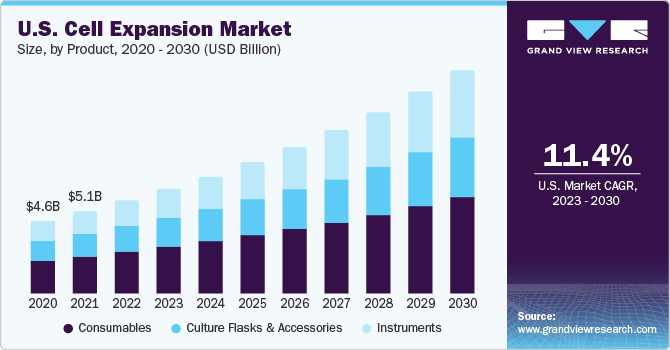The global cell expansion market was valued at approximately USD 17.75 billion in 2022 and is projected to experience significant growth, with an expected compound annual growth rate (CAGR) of 12.85% from 2023 to 2030. One of the key drivers of this market is the increasing adoption of automated solutions in cell expansion applications. These automated systems significantly reduce the need for manual labor and lower production costs associated with Cell Therapy Products (CTP), gene therapies, and other biologics, thereby ensuring more robust and reliable processes.
Another important trend shaping the market is the paradigm shift towards Single-Use Systems (SUS) in CTP manufacturing. SUS systems provide considerable advantages, such as eliminating concerns related to cross-contamination and culture contamination that can arise from inadequate sterilization practices. Additionally, these systems enable the production of CTP at high cell densities, which not only enhances productivity but also leads to long-term cost savings. Consequently, the rising adoption of SUS is expected to accelerate the development of CTP, further boosting overall market growth.
Cellular therapies are increasingly gaining traction within the life sciences industry, supported by a notable rise in funding from both private and government entities. Initiatives aimed at encouraging the development of cellular therapies serve as additional drivers for market expansion. Organizations like the International Society for Stem Cell Research play a vital role in identifying funding opportunities related to stem cell research across various biomedical applications.
Gather more insights about the market drivers, restrains and growth of the Cell Expansion Market
Cell Type Insights
In terms of cell types, the segment of mammalian cells held the highest revenue share in 2022 and is anticipated to maintain its dominance throughout the forecast period. This preference is primarily due to the suitability of mammalian cell culture systems in the production of complex protein therapeutics. These systems closely mimic the pharmacokinetics and functional attributes relevant to human post-translational modifications. As a result, a majority of biopharmaceuticals—including monoclonal antibodies, specific interferons, thrombolytics, and various therapeutic enzymes—are produced using these culture systems.
The segment of differentiated human cells also accounted for a significant share of the revenue, as these cells perform specialized functions within the body. For example, differentiated cells such as fibroblasts are increasingly important in applications related to cutaneous wound healing and skin bioengineering, thereby driving segment growth. Additionally, the exploration of 3D Gingival Fibroblast (GF) toroids as a viable and straightforward in vitro assay for biomaterial testing has expanded the utilization of these differentiated cells.
Human stem cells are rapidly gaining attention and are expected to witness the highest CAGR during the forecast period. This rapid growth can be attributed to a surge in research activities within this field and the remarkable success of regenerative medicine. The implementation of automated, robotic, and closed production systems for clinical-grade mesenchymal stem cell production is further propelling this segment's expansion.
A notable example of advancements in this area is the partnership announced in June 2022 between STEMCELL Technologies and PBS Biotech. This collaboration aims to make the PBS-MINI Bioreactor available to researchers for scaling up human pluripotent stem cell (hPSC) cultures. The partnership focuses on providing reliable and scalable suspension culture systems, enabling scientists to obtain the necessary quantity and quality of cells for advanced research initiatives.
Cell expansion market is positioned for substantial growth driven by the increased use of automation, the advantages offered by Single-Use Systems, and the rising interest in cellular therapies supported by significant funding. The dominance of mammalian cells and the rapid growth of human stem cells further underscore the dynamic nature of this market, while ongoing innovations and partnerships enhance the overall landscape of cell expansion technologies. As the industry continues to evolve, it will be critical for stakeholders to adapt to these trends to harness the full potential of the cell expansion market.
Order a free sample PDF of the Cell Expansion Market Intelligence Study, published by Grand View Research.


